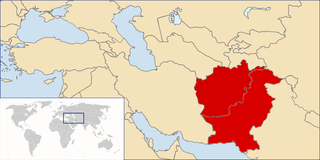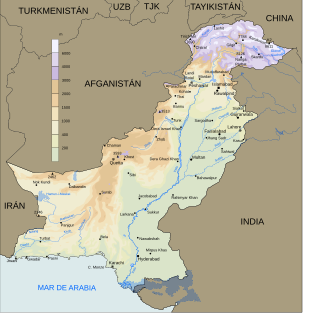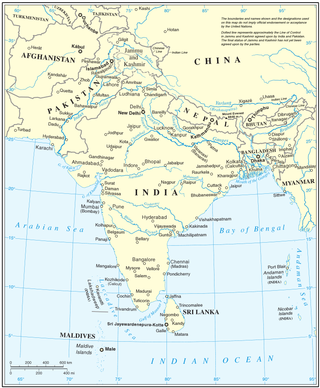Related Research Articles

Pakistan's climate varies from a continental type of climate in the north (Gilgit-Baltistan,Kashmir,KPK), a mountainous dry climate in the west (Baluchistan), a wet climate in the East (Punjab) an arid climate in the Thar Desert, to a tropical climate in the southeast (Sindh), characterized by extreme variations in temperature, both seasonally and daily, because it is located on a great landmass barely north of the Tropic of Cancer.
Events from the year 2010 in Pakistan.
Events in the year 2014 in Pakistan.

In August 2013, Pakistan and eastern Afghanistan experienced heavy rain that led to flash flooding. More than 180 died as a result of the floods.

On the night of 26 April 2015, a severe storm hit areas of Khyber Pakhtunkhwa, Pakistan, causing considerable damage in the cities of Peshawar, Nowshera, and Charsadda. The storm featured heavy rains accompanied by hail and high-speed winds of over 120 kilometers per hour. As a result of the storm's damaging effects, 45 people were killed and over 200 were wounded.
The following lists events that happened during 2016 in Pakistan.
Operation Radd-ul-Fasaad was a combined military operation by the Pakistani military in support of local law enforcement agencies to disarm and eliminate the terrorist sleeper cells across all states of Pakistan, started on 22 February 2017. The operation aimed to eliminate the threat of terrorism, and consolidating the gains of Operation Zarb-e-Azb which was launched in 2014 as a joint military offensive. It was further aimed at ensuring the security of Pakistan's borders. The operation underwent active participation from the Pakistan Army, Pakistan Air Force, Pakistan Navy, Pakistan Police and other Warfare and Civil Armed Forces managed under the Government of Pakistan. More than 375,000 intelligence-based operations had been carried out as of 2021. This operation has been mostly acknowledged after Operation Zarb e Azb.
From February to April 2019, widespread flash flooding affected large parts of Pakistan, most severely in Balochistan, KPK, Punjab, and other provinces. Pakistan has been hit by three major waves of rain and flooding over the course of more than one month. The first wave of rain began on 20 February, leading to flooding in to Khyber and Balochistan, therefore many villages and several cities have been evacuated, and more than 1,500 families has been rescued alone in Balochistan and many in other states. The 20 February rain and thunderstorms caused flash floods in the Lasbela area. The main areas affected were Turbat, Tump, Nasirabad and Dasht where 300 people were displaced due to the flood. These people were then moved to camps established by the Provincial Disaster Management Authority (PDMA). Casualties have came mostly due to roof collapsing amid heavy rains and flash flooding. Khyber Pakhtunwkha has witnessed the most deaths till now, 40, alongside Balochsitan has faced 26 casualties with more than 9 in Punjab and other places. Due to rain, flood and storm casualties are increasing.
In mid-March 2019, monsoonal downpours caused widespread flooding and landslides across South Asia.
This article is an incomplete outline of terrorist incidents in Pakistan in 2021 in chronological order.

In 2016 Pakistan experienced higher rainfall than normal (10-20%), especially in the pre-monsoon season. Heavy monsoon rains are common in the region. This led to multiple periods of flooding, landslides, and damage particularly in Northern Pakistan. The Swat River overflowed and multiple landslides occurred around Pakistan including in Khyber Pakhtunkhwa, Gilgit-Baltistan, Azad Jammu, and Kashmir.

From January to October 2022, excessive rainfall and widespread monsoon flooding occurred in the South Asian countries of Afghanistan, Bangladesh, India, Nepal, Pakistan, and Sri Lanka. It has become the region's deadliest floods since 2020, with over 4,700 people dead.

After over 6,500 people died in flooding in 2020, monsoon floods hit South Asia again in 2021.
The events listed below are both anticipated and scheduled for the year 2023 in Pakistan.

Flooding affected parts of South Asia since March of 2023, killing many and destroying buildings.
The events listed below are both anticipated and scheduled for the year 2024 in Pakistan.
Since 29 February 2024, flooding affected various regions across the country, including Sindh, Balochistan, Khyber Pakhtunkhwa, and Gilgit-Baltistan. At least 40 people were killed and 62 injured in the floods. Floods caused by heavy rains caused widespread destruction, disrupting normal life and damaging infrastructure. The government declared a state of emergency in several areas, and relief operations were launched by various agencies, including the Pakistan Navy, Pakistan Army, and the Frontier Corps.

Since 6 March 2024, unusually heavy rains and resulting flash flooding in Afghanistan and Pakistan killed over 1,000 people, and injured many more. The flooding extensively damaged infrastructure and agriculture as well.
References
- 1 2 3 4 "2 weeks of monsoon rains in Pakistan have killed at least 55, including 8 children". Associated Press. 6 July 2023. Retrieved 7 July 2023.
- ↑ "Global Catastrophe Recap December 2020" (PDF). Aon Benfield Analytics. Retrieved April 25, 2021.
- ↑ Richard Davies. "Pakistan – Flood Chaos in Karachi, Monsoon Death Toll Rises to 187".
- ↑ "NDMA Floods (2022) SITREP - 2022 (Daily SITREP No 158 Dated 18th November, 2022)" (PDF). National Disaster Management Authority . 18 November 2022. Retrieved 27 November 2022.
- 1 2 "At least 76 died, 133 injured due to heavy rains in Pakistan". Times of India. 9 July 2023. Retrieved 10 July 2023.
- 1 2 3 "86 Killed, 151 Injured In Pakistan Rain Fury: Report". NDTV. 11 July 2023. Retrieved 11 July 2023.
- 1 2 "Pakistan – Deadly Floods in Balochistan Province". floodlist.com. 1 May 2023. Retrieved 7 July 2023.
- ↑ "Human rights in Pakistan". Amnesty International. Retrieved 2023-10-30.
- ↑ "Pakistan – 11 Dead as Rain and Flash Floods Cause Houses to Collapse in Khyber Pakhtunkhwa". floodlist.com. 3 April 2023. Retrieved 7 July 2023.
- ↑ "Pakistan – Flash Floods and Strong Winds Leave Over 20 Dead in Khyber Pakhtunkhwa". floodlist.com. 12 June 2023. Retrieved 7 July 2023.